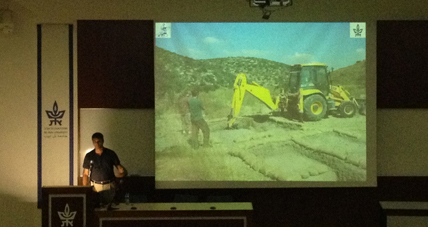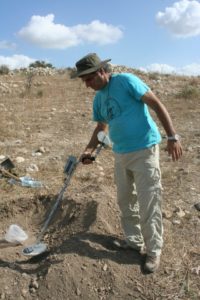Bulldozer Archaeology

An archaeological controversy has erupted in Israel which has serious implications for anyone interested in the history of the Holy land. At the center of the controversy is Professor Yuval Goren from Tel Aviv University. Goren has a PhD. in petrography, which is a branch of petrology that focuses on detailed descriptions of rocks. Though he doesn’t have a graduate degree in archaeology, he de facto works as an archaeologist. A few months ago, Goren shocked an audience at Tel Aviv University by proudly featuring his method of archaeological excavation using a Caterpillar bulldozer.
Biblical Archaeology Review (BAR) dubbed Professor Goren’s technique as “Cater-pillaging”. Archaeologists normally dig with spades and toothbrushes. The position of every coin is important for identifying strata and for dating. Every pottery shard and its location can influence the overall understanding of the site. But at Tel Socoh, where Goren is digging, the archaeology was going slowly and Goren decided to speed things up. That’s where the bulldozer came in. Clearly, bulldozers are not conventional archaeological tools, and Professor Goren came under severe criticism. Dr. Robert Deutsch took an uncompromising stance against the practice and I have been blogging against it as well (here and here). Now, in BAR’s latest issue, someone has once again anonymously published an ad featuring Professor Goren and his bulldozer. Goren has reacted with anger calling the ad “defamatory” and some colleagues at Tel Aviv University have posted a defense of the practice.

Originally, Professor Goren defended himself by saying that his bulldozer was not on Tel Socoh, but in a valley south of it. I’m not sure why that should make a difference, but there you go. He went on to say that he only resorted to the bulldozer after an “entire week” of painstaking archaeology looking for a “lost ceramic workshop”. It was only then that he “decided to make…a trial trench with a digger” i.e., a bulldozer of the Caterpillar variety. In yesterday’s statement by faculty members at Tel Aviv University the signators repeated the misleading statement that there was “no use of a mechanical excavator on Tel Socoh”. This is clearly a cynical word game. Everyone looking at the photograph can see the bulldozer and it really doesn’t matter whether the bulldozer was on top of the Tel i.e., the archaeological mound, or at the bottom. Their second point is that the Caterpillar was only used after a “systematic manual excavation”. This is new and very bad. Usually, those who argue in favour of the bulldozer say that it should be used prior to a manual excavation. The reasoning behind this is that there is such a thing as a “controlled” excavation using bulldozers. The idea is that you first create a trench using the digger. After this, a trained archaeologist inspects the trench and decides whether it’s worthwhile switching to conventional methods. Again, this is a cynical word game. Anyone who has been around a bulldozer knows that there is nothing “controlled” about its use in an archaeological setting. By its nature, a bulldozer is destructive. When deciding to use one for digging a trench, basically, an archaeologist is taking a calculated risk to destroy a “limited” amount of archaeology in the hope of digging in the right place, and discovering significant finds with the use of conventional methods. All that the defenders of Goren’s bulldozer are saying is that professionals have the right to gamble with our history in the hope of hitting an archaeological jackpot. But what they can never know is whether they are destroying the jackpot in the process. By digging the “controlled trench” the bulldozer may destroy an Egyptian scarab only a few centimeters long, a tiny signet ring, or a small inscription. Only last week, such an inscription, carved on a tiny pottery shard, made world headlines. It is a 2,700 year old Hebrew writing found in the City of David, outside Jerusalem’s Old City walls. Lucky for us, Goren and his bulldozer were nowhere near this excavation.
What is even more incredible about the Tel Aviv University statement in support of Professor Goren is its Orwellian connotations. The authors of the statement believe that they can make us doubt what we can plainly see with our own eyes. When you look at the slide behind Professor Goren in our picture, you see standard archaeological 5×5 meter squares and then you see a Caterpillar smashing into one of those squares. This is not some trench at the periphery of the excavation. This is a bulldozer churning up the excavation itself. But the Tel Aviv crowd goes even further. They tell us that this methodology is “authorized and endorsed” by the Israel Antiquities Authority (IAA). I contacted the IAA and no one would go on record endorsing the bulldozer methodology. Furthermore, Goren’s supporters argue that this is a “common method in archaeology”, and that “most seasoned archaeologists….use mechanical excavators [i.e., bulldozers] in certain, closely controlled circumstances”. Whoever reads this line should have his/her jaw drop. What these people are saying is that they can “control” a bulldozer as it’s ripping through the ground and that, under pressure of producing results, they routinely destroy unexcavated treasures of our Western heritage.
The Tel Aviv University statement is signed by colleagues of Professor Goren. Many of them are not archaeologists but, surprisingly, the list includes seasoned archeologist Professor Israel Finkelstein who, to the best of my knowledge, never used a bulldozer at his excavation in Megiddo. More important than who signed the statement, is who did not sign it. Legendary Tel Aviv archaeologist David Ussishkin – excavator of Lachish and Megiddo – never used a Caterpillar and did not sign the statement. Also notable by their absence are Tel Aviv archaeologists Ran Barkai, Avi Gopher and Dr. Mario Martin.
There’s no question that there’s a lot of professional pride involved in this debate. Clearly, Professor Goren is not used to having his work analyzed in the media. But the world of archaeology has been without journalistic scrutiny for too long. It’s not enough for journalists to sit on the sidelines waiting for the next press release from archaeologists slapping themselves on the back when announcing their latest find. Journalists have a duty to report critically and archaeologists have a responsibility to listen. Instead of defending this abominable practice, Goren and his allies should hang their heads in shame and promise not to dig with bulldozers anymore. The fact is they are not destroying their personal property. They are smashing through our common history. It’s our history, Professor Goren, please keep your bulldozer away from it.
Click here to see my recent article “History Envy” on The Times of Israel.

